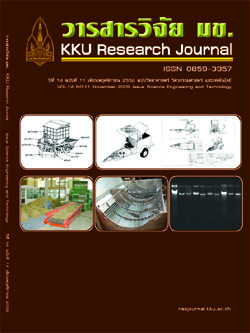Effect of jatropha curcas oil on properties of carbon black-filled styrene-butadiene rubber/natural rubber blends (Thai)
Main Article Content
Abstract
This research aims to study and compare the influences of Jatropha curcas oil on properties of carbon black-filled styrene-butadiene rubber (SBR) / natural rubber (NR) blends. Preparation of the rubber compounds was carried out by blending styrene-butadiene rubber with natural rubber at different proportions. The content of Jatropha curcas oil or paraffinic oil was varied from 0.0-9.0 parts per hundred of rubber (phr). The processability and mechanical properties of the rubber compounds were then investigated. The results revealed that two types of processing aids could improve the processability of the rubber compound, i.e., both viscosity and mixing energy were found to decrease with increasing processing aid content. The tensile and tear strengths of the NR/SBR blends increase with increasing NR percentage. The results obtained also indicate that the addition of Jatropha curcas oil does not significantly affect the mechanical properties of the blends.
Article Details
References
Akovali, G., Ulkem, I. 1999. Some performancecharacteristics of plasma modified carbonblack in the (SBR) matrix. Polymer 40:7417-7422.
Baarle, B. V. 1997. Processing Aids. Newsletter ofthe Rubber Foundation InformationCenter for Natural Rubber 9: 9-10.
Coran, A. Y. 2003. Chemistry of the Vulcanizationand Protection of Elastomers: A Review ofthe Achievements. Journal of AppliedPolymer Science 87: 24-30.
Furtado, C.R.G., Leblanc, J.L., Nunes, R.C.R. 1999.Fatigue resistance of mica- carbonblack-styrene butadiene rubber (SBR)compounds. European Polymer Journal35(7): 1319-1325.
George, S.C., Ninan, K.N., Greonincks, G., Thomas,S. 2000. Styrenebutadiene rubber/naturalrubber blends: morphology, transportbehaviour, and dynamic mechanicalproperties. Journal of Applied PolymerScience 78(6): 1280-1283.
Hotmann, Werner: Rubber technology handbook.Munich; Vienna; New York: Hanser; NewYork: Oxford University Press, 1989.
Ibarra, L., Posadas, P. and Esteban-Martinez, M.2004. Influence of Some Additives on Rheological Properties, Viscosity, andDynamic Mechanical Properties in NRCompounds. Journal of Applied PolymerScience 94: 332-344.
Ismail, H. and Anuar, H. 2000. Palm Oil Fatty AcidAs an Activator in Carbon Black FilledNatural Rubber Compounds: DynamicProperties, Curing Characteristics, Reversionand Fatigue Studies. Polymer Testing 19:349-359.
Ismail, H., Hairunezam, H.M. 2000. The effect ofcompatibilizer on curing characteristics,mechanical properties and oil resistance ofstyrene butadiene rubber/epoxidized naturalrubber blends. European Polymer Journal137: 39-44.
McDonel, E.T., Baranwal, K.C., Andries, J.C. In:Paul DR, Newman S, editors. 1978.Polymer blends vol. 2. New York:Academic Press; [Chapter 19].
Menon, A. R. R., Aigbodion, A. I., Pillai, C. K. S.and Mathew, N. M. 2002. ProcessabilityCharacteristics and Physico-MechanicalProperties of Natural Rubber Modified withCashewnut Shell Liquid and CashewnutShell Liquid-Formaldehyde Resin. EuropeanPolymer Journal 38: 163-168.
Rattanasom, N., Prasertsri, S. 2009. Relationshipamong mechanical properties, heat ageingresistance, cut growth behaviour andmorphology in natural rubber: Partialreplacement of clay with various types ofcarbon black at similar hardness level.Polymer Testing 28: 270-276.
Okieiman, F.E. 2002. Studies in the utilization ofepoxidesed vegetable oils as thermalstabiliser for polyvinyl chloride. IndustrialCrops and Products 15: 71-75.


